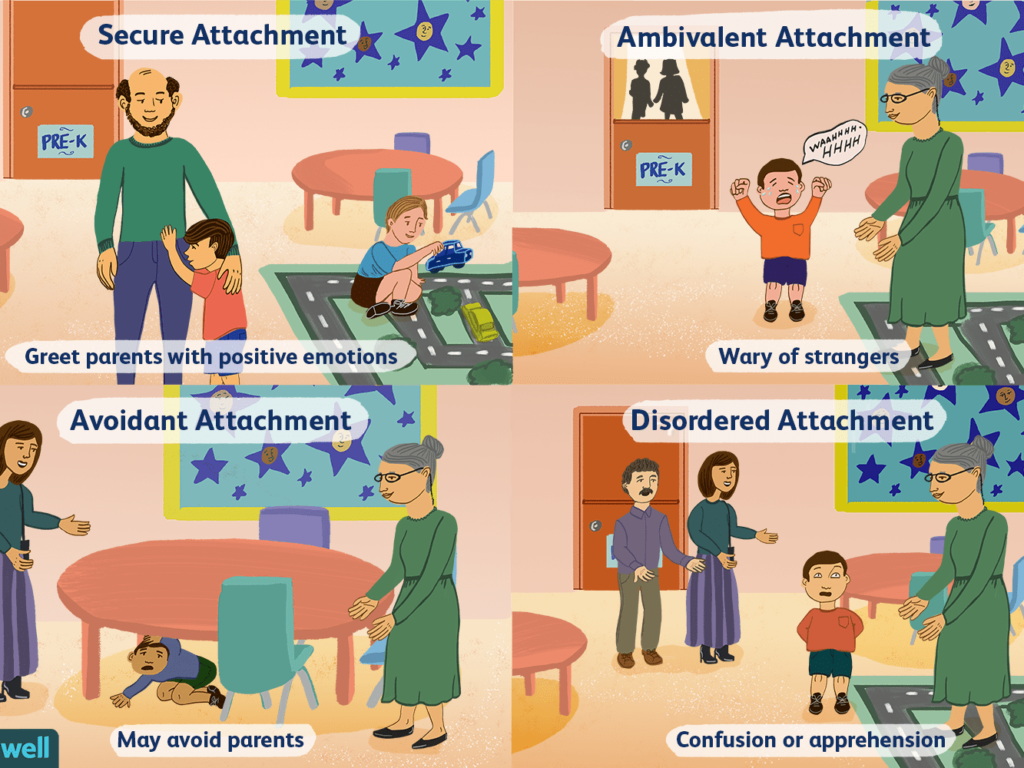Have you ever wondered why some women are attracted to the “bad boy?” And where the phrase “nice guys always finish last” came from?
You might just think that women are attracted to guys with muscles, on motorcycles who are independent and tough. While that might be true of some women, not all feel that way.
Actually, this phenomenon is way more complex than an attraction to the “bad boy” or the automatic rejection of the “nice guy.” It’s called the The Attachment Theory.
What is Attachment Theory?
The Attachment theory is very deep. It’s rooted in our very early childhood, and the feelings, emotions, and actions that were given to us by our primary caregivers. All of this information gets stored into our subconscious mind, which results in some unexplained behavior later in life.
Okay, let me be a little more clear here. The theory is explaining how we respond in relationships when we get hurt, perceiving a threat (emotional or physical), or being separated from loved ones.
Just think about the term “attachment.” Literally speaking, you can attach something to just about anything. You sew a button on your pants, you can tape a balloon to a string, and you can pound a nail into a wall. All of these are acts of “attachment.”
But obviously, we’re talking about people and relationships here. And just like you can tape a balloon to a string, people have different levels of emotionally attaching to other people.
After all, relationships are about a mutual bond, right? In order for there to be a bond, there has to be some sort of attachment to another person.
The type of attachment style we develop later in life is directly related to how we were treated as infants and toddlers by our primary caregivers.
For instance, maybe one person had a very attentive and loving caregiver. This teaches the baby/toddler that people are reliable. That they will always care for you and they don’t have to worry about if they are going to leave or not.
But perhaps another person’s caregiver was neglectful. That teaches the person that people are not to be trusted. That they are unreliable and can’t be counted on.
Why is it Important to Understand Attachment Theory?
Have you ever dated or been in a relationship with someone where you felt like you were chasing them? You made all the efforts, and they didn’t seem as invested in the relationship as you were. And because of that, the relationship suffered.
Or, on the flip side, perhaps you’ve had women chase YOU, and you felt like they were needy and annoying.
Well, these behaviors are all rooted in The Attachment Theory.
As I said earlier, all this information that we get from our primary caregivers gets stored in our subconscious minds and comes into play in our adult relationships – for better or for worse.
Relationships aren’t always easy. However, if you can understand yourself and your partner better, then relationships can be healthy and happy. And understanding attachment styles is just one vital piece to the relationship puzzle.
The Anxious Attachment Style & Where it Comes From
Like all of the attachment styles, anxious attachment style comes from your parents. Their behavior is sometimes erratic toward the child. Sometimes, they will be nurturing, attuned, and respond well to their children’s needs. But other times, they are insensitive and emotionally unavailable.
In other words, the parents vacillate between these very different kinds of behavior. Because of this, the children are confused and insecure because they never know which kind of treatment will be coming from the parent.
As children, a person with anxious attachment style becomes distrustful or suspicious of others, and so they act clingy and desperate. They learn that the best way to get their needs met is to cling to the parent.
As you might guess, these behaviors are often carried into adulthood and repeated in their romantic relationships.
Adults with this attachment style tend to be insecure and self-critical. They often seek reassurance and approval from others. They do this to relieve their self-doubt, but it never usually works.
Additionally, they have deep-seated feelings that they are going to be rejected, which makes them worried, clingy, and overly dependent on their partner.
Their insecurity leaves them emotionally desperate in their relationships, and they often take on the role of the “pursuer.” They have positive views of other people and relationships, but rely on other people to validate their self-worth.
The Avoidant Attachment Style & Where it Comes From
People with avoidant attachment styles might have had some losses and traumas in their childhood such as sexual abuse.
An avoidant attachment style is characterized by the need to protect yourself and stay away from relationships, while at the same time, you also have an urge to be in a relationship.
Yes, very contradictory.
When a person has this style, they really struggle with deep intimacy and trust. They tend to feel uncomfortable with emotional closeness, and that is mixed with negative views about themselves. They think they are unworthy of attachments, and they might not trust the intentions of the person who wants to attach to them.
People with this attachment style might even unconsciously create situations or reasons to sabotage close relationships. They can connect at first, but then they pull away when the relationship becomes to feel too intense.
That may sound counter-intuitive to most people, but because of the nature of their childhood, this behavior becomes instinctual to them.
They also don’t talk about or notice feelings and emotions much. They suppress their emotions and often lack awareness of their own feelings.
As a result of this behavior, a lot of their relationships tend to be very shallow because they can’t attach – or accept attachment – from other people.
The Secure Attachment Style & Where it Comes From
Unlike people with the anxious or avoidant attachment styles, people with a secure style move through the world much differently.
Their caregivers promoted relationships in which they were emotionally available to the child. They responded to the child’s needs appropriately, and as a result, the child learned that it was safe to attach themselves to another person.
Because their parents were reliable and emotionally available, they tend to feel much more secure in adult relationships than those with anxious and avoidant styles. They feel like it’s easy for them to emotionally connect with people, and they are comfortable depending on others and having others depend on them.
They also don’t worry about being alone or being accepted by other people. This is because they tend to have higher self-esteem and don’t rely on other people for their sense of self-worth.
People with secure attachment styles tend to have more satisfying relationships with other people. That is because there is little-to-no fear associated with having a close relationship. Unlike the anxious and avoidants, they see rewards in relationships, and have healthier relationships in general.
How to Recognize When You’re Being Triggered into Anxious Attachment Style & What to Do About It
Consider this scenario. You go out on a date with a new woman. You really like her a lot, and you think things are going well. She has great body language, is flirty with you, and the conversation flows impeccably. At the end of the evening, you are sure that she is into you and you will have a second date soon.
After you part ways, you text her when you get home, even though it’s late. You say how nice it was to meet her and you really enjoyed her company. And you even ask for another date (did you forget to use a TDL when you were in person with her?).
Of course, you’re hoping for an immediate reply since you really liked her. Instead, the minutes turn into hours. Which turns into the morning.
And still no response.
Your mind starts racing. You think, “What did I do wrong? Why doesn’t she like me? Was she leading me on? Is she rejecting me?”
All these negative thoughts start racing through your head. And as the minutes tick by, you become more and more anxious about it, and it starts to overwhelm you.
Your logical side might even take over temporarily and think, “Hey, if she doesn’t like me, no biggie. There are more fish in the sea!”
But your anxiety is too powerful, and it wins over your logic.
So, you double-text her, wishing her a good morning and a wonderful day… even though she hasn’t texted you back yet.
Then you wait again. And you start kicking yourself thinking, “Why did I do that?”
Well, you did that because you have an anxious attachment style. Your anxiety in relationships gets the best of you. Even when you try to resist it, usually you can’t. And as a result, you become the “chaser.”
So, What Can You Do About It?
Are you doomed to feeling anxious for your whole life?
No, of course not.
It all starts with a different mindset. Yes, it’s easier said than done, I know. Because all of these anxious feelings are ingrained in our subconscious from childhood, they are difficult to overcome.
That’s where your logical mind, and other people can help.
Any time you start to feel anxious, step back and breathe. Instead of chasing her, realize that if your relationship is really “meant to be,” then you won’t have to chase her. She will be equally as responsive to you as you are to her. After all, that’s what relationships should be like!
It’s not easy, but you have to love and value yourself enough to be able to deal with rejection.
Rejections doesn’t mean that there’s something wrong with you, it just means that you are not a good match with that woman.
See? It’s much easier to accept that than thinking that you’re some loser that she’s running away from.
How to Recognize When You’re Being Triggered into Avoidant Attachment Style & What to Do About It
And here’s a common scenario with an avoidant attachment style.
You go out with a woman, and you are very smitten. The conversation is stimulating, and you are very attracted to her – and her to you. After many hours, you go out to her car and start making out. You say things to her like, “I could stay here for the next 50 years!” She thinks you mean it.
Over the next few weeks, you both seem equally into each other. You see each other regularly, and seem to be becoming a couple.
But you don’t text her much. For some reason, you don’t know what to say when you do. It feels awkward to you. You think it’s because you don’t like texting. But in actually, it is probably because, subconsciously, consistent communication (via text or phone) represents emotional connection to you.
So, you find yourself not asking her out on dates as much as you did at first. You say you’re going to show up on a date, but then you say you’re not feeling well and cancel on her. And you do this more and more.
And you probably don’t even know why you’re doing it. I mean, you really like this girl. She’s attractive, smart, witty, and pretty much everything you want. So why are you backing away?
Then, one day, six weeks into seeing her, you simply ghost her. You say you’re going to show up for the weekend, make up some lame excuse, and then never text her again.
She’s probably left wondering, “What the heck just happened? I thought things were going so well?”
And that’s probably why you pulled away. Things were going TOO well.
How Does This Makes Sense?
That might not make sense to other people, but to avoidant attachers, it makes perfect sense.
In order to overcome these avoidant urges, try to recognize your behavior. Step outside yourself and try to see it from the other person’s point of view.
Is your behavior becoming more distant? Have your communication habits changed? Are you going on less dates? Do you feel anxiety over the thought of growing closer to her?
All of these are indicators that you are becoming avoidant.
It’s not easy to overcome them, but you can’t change what you don’t recognize. So, if you really like someone and want to keep her in your life, you must stop yourself from your instinctive habits of pulling away when things get too emotional for you.
How to Become Secure in Your Attachments
Everything starts with you. Okay, well, it really started with your caregivers in your childhood, but NOW it’s all up to you. Only you can control your thoughts, emotions, and behavior. And it all starts with awareness.
Once you have identified your self-defeating behaviors in relationships, you have to be conscious of it when you fall back into those patterns. And then just like a friend might give you advice and tell you to stop, you have to do that for yourself.
And it all starts with self-love. If you love yourself enough, you will not feel inadequate when it comes to relationships. You won’t chase after people, and you won’t avoid connecting with people. Because you know you are worthy.
If you can’t do this by yourself, enlist the help of a friend or a therapist. Therapists can work wonders on how you feel about yourself and help you change your behaviors so you can have more fulfilling relationships.
And when you’re ready to move forward, consider hiring a dating coach, like myself, to help you find a long term partner who’s just right for you.
Self-Defeating Cycle: Why Anxious Types are Often Attracted to Avoidant Types and Vice Versa
You might think it sounds logical that perhaps anxious types would be attracted to other anxious types. And the same for avoidant types. It seems like it would work better that way, right? Well, that’s not always the case.
Many times, anxious and avoidant types are attracted to each other.
Sounds crazy, right?! Not if you think about it. If anxious attachers are used to being rejected by their primary caregivers, then if they get involved with avoidant types, well, they are re-creating what feels “normal” to them – even if they don’t like it. They are used to being rejected, and that’s why they are drawn to people who make them become the pursuer.
And if avoiders get involved with attachers, it further validates their need to pull away. They can blame their avoidant behavior on the attacher – they are too “needy” so that’s why they run away.
It all comes down to what’s familiar to us. But familiarity isn’t always healthy. In fact, many times, it’s very unhealthy.
Final Thoughts
Relationships are very complex because they go beyond just two people. Our thoughts and emotions that are deeply rooted in our subconscious mind come rearing their ugly heads when we get emotionally triggered.
Change starts with knowledge and acceptance. Now that you have identified the different attachment styles, not only can you control your behavior better, you can be on the lookout for potential partners with their own, and you can understand them better as well.


